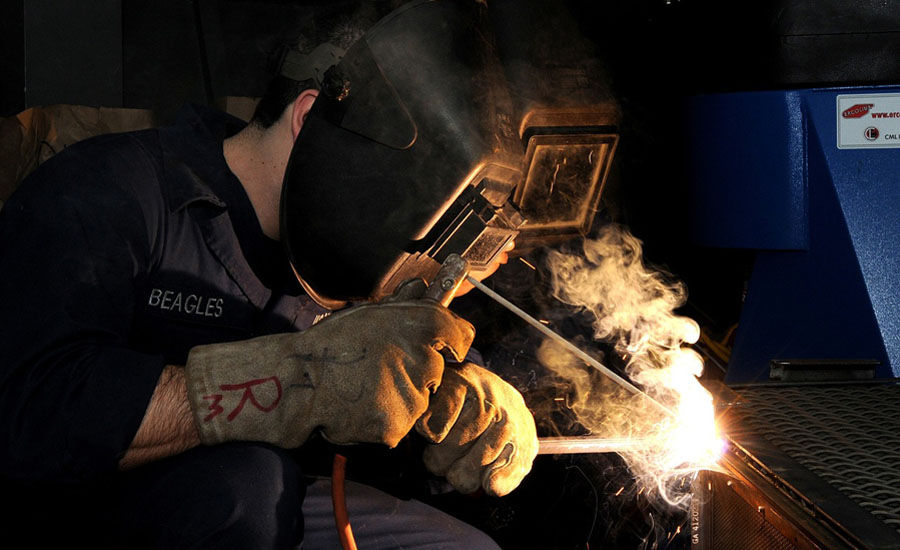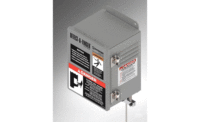Organizations such as the American Conference of Governmental Industrial Hygienists (ACGIH®) and OSHA offer safety guidelines to help employers and workers avoid welding hazards. Employers should ensure all workers have an opportunity to comply with the following important guidelines in the workplace:
• Read and understand manufacturer instructions for equipment
• Carefully review material safety data sheets
• Follow your company’s internal safety practices
• Awareness of the most common welding hazards and knowing how to avoid them ensures a safe, productive work environment for all.
Electric shock
Electric shock is one of the most serious and immediate risks facing a welder. The higher the voltage, the higher the current and, thus the higher the risk for the electric shock to result in injury or death.
The most common type of electric shock is secondary voltage shock from an arc welding circuit, which ranges from 20 to 100 volts. Even a shock of 50 volts or less can be enough to injure or kill an operator, depending on the conditions. Due to its constant change in polarity, alternating current (AC) voltage is more likely to stop the heart than direct current (DC) welders. It is also more likely to make the person holding the wire unable to let go.
To avoid secondary voltage shock, welding operators should wear dry gloves in good condition, never touch the electrode or metal parts of the electrode holder with skin or wet clothing and insulate themselves from the work and ground, keeping dry insulation between their body and the metal being welded or ground (such as a metal floor or wet surface).
Welding operators also should inspect the electrode holder for damage before beginning to weld and keep the welding cable and electrode holder insulation in good condition. The plastic or fiber insulation on the electrode holder prevents contact with the electrically “hot” metal parts inside. Repair or replace damaged insulation before use. Also, stick electrodes are always electrically hot, even when welding is not being done and the voltage is the highest.
An even more serious shock, primary voltage shock, may occur when a welder touches electrically “hot” parts inside the welder case or the electric distribution system to which the welder is connected. This action can lead to a shock of 230 or 460 volts.
When not in use, but still turned on, most welding equipment have a voltage that ranges from 20 to 100 volts at the welding circuit and voltages inside the welding equipment may range from 120 volts to more than 575 volts, all of which pose a risk for electric shock.Only qualified repair technicians should attempt to service or repair welding equipment.
Fumes and gases
Overexposure to welding fumes and gases can be hazardous to your health. Welding fume contains potentially harmful complex metal oxide compounds from consumables, base metal and the base-metal coatings. It’s important to keep your head out of the fumes and use enough ventilation and/or exhaust to control your exposure to substances in the fume, depending on the type of rod and base metal being used.
The specific potential health effects which relate to the welding consumable product being used can be found in the health hazard data section of the safety data sheet available from your employer or the consumable manufacturer.
(TLV®) and OSHA permissible exposure limits (PEL) for the substances in welding fume specify the amount of a substance in your breathing air to which welding operators can be exposed every day they work over the course of their career. Welding operators should wear an approved respirator unless exposure assessments are below applicable exposure limits. An industrial hygienist takes an air sample in the worker’s breathing zone to determine whether a worker’s exposure is below the exposure limits.
If the air in your breathing zone is not clear, or if breathing is uncomfortable, check to be sure the ventilation equipment is working and report concerns to a supervisor so your exposure to substances in the welding fume can be checked. To prevent exposure from coatings such as paint, galvanizing, or metal platings on base metals, clean the base metal before beginning to weld. See a doctor if symptoms from overexposure persist.
Fire and explosions
The welding arc creates extreme temperatures, and may pose a significant fire and explosions hazard if safe practices are not followed. While the welding arc may reach temperatures of 10,000 degrees Fahrenheit, the real danger is not from the arc itself, but the heat, sparks and spatter created by the arc. This spatter can reach up to 35 feet away from the welding space.
To prevent fires, before beginning to weld inspect the work area for any flammable materials and remove them from the area. Flammable materials are comprised of three categories: liquid, such as gasoline, oil and paint; solid, such as wood, cardboard and paper; gas, including acetylene, propane and hydrogen.
Know where the fire alarms and extinguishers are located, and check the extinguisher’s gauge to make sure it is full. If an extinguisher is not available, be sure to have access to fire hoses, sand buckets or other equipment that douses fire. And know the location of the nearest fire exit.
If welding within 35 feet of flammable materials, have a fire watcher nearby to keep track of sparks, and remain in the work area for at least 30 minutes after finishing welding to be sure there are no smoldering fires. Put a fire-resistant material, such as a piece of sheet metal or fire resistant blanket, over any flammable materials within the work area, if you can’t remove them.
In an elevated location, make sure no flammable materials are beneath you, and watch out for other workers below you in order to prevent dropping sparks or spatter on them. Even high concentrations of fine dust particles may cause explosions or flash fires. If a fire starts, don’t panic – and call the fire department immediately.
Source: Lincoln Electric http://www.lincolnelectric.com



